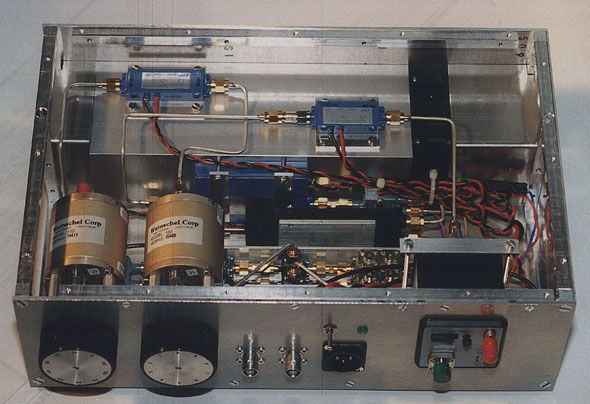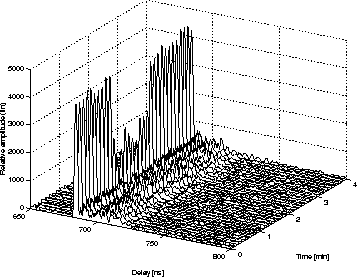
 | Wireless CommunicationChapter: Wireless Propagation Channels |
Contributed by Peter E. Leuthold and
Pascal Truffer

|
The wideband channel sounder called ECHO 24
(Enhanced Channel Sounder operating at 4 GHz) measures highly time-variant CIR's
by employing a correlation method. It achieves a 2 ns path delay
resolution.
For a coherent demodulation of the transmitted signal the receiver has
to be provided with a reference signal at the carrier frequency
|
|
The block diagram of the sounder system which consists of a
transmitter (Tx) and a receiver (Rx) module as well as of a control
station, is depicted in Figure 7. The optical part of
the control station contains a laser diode (LD) and two Mach-Zehnder
interferometers (MZI), which are used as light wave modulators. A
quadrature modulation (I/Q Mod) is performed by means of a PN code
impressed on the local oscillator signal (LO). The resulting signal
controls the first MZI which generates a double sideband suppressed
carrier (DSSC) modulation of the laser light for the Tx module. The laser light
supplied to the Rx module is modulated at the second MZI by the local
oscillator signal only. Real and imaginary parts of the received
signal are returned to the control station by means of two standard
coaxial cables where they are sampled for data acquisition purposes.
The subsequent offline data processing requires the knowledge of the
PN sequence. Both, the Rx and the Tx module are equipped with a
wideband |
The measured CIR of a time-variant indoor channel is shown in Figure 8. The Tx and the Rx module are set up in a distance of five meters. After one minute a person enters in between for another minute. The line of sight (LOS) path is attenuated, while the indirect paths are not influenced by that person.
A detailed description of ECHO 24 is given in [9]. You can view 3 pictures of the hardware here.

Figure: The CIR of a time-variant indoor channel at 24 GHz
![]()